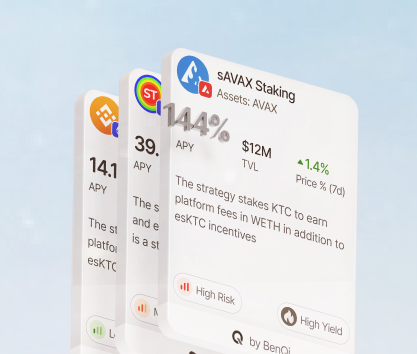Yield Farming is the defining investment option in the DeFi sector. When it comes to generating profits, it is hard to find a better approach. The core idea behind this method is that decentralized protocols can attract liquidity providers at a relatively low cost by offering native utility or governance tokens as rewards on top of tiny yields in base assets. As the crypto market is largely speculative with volatility reaching 10% and even more for less stable coins, investors can extract massive profits given they time their exit correctly.
The rise of decentralized finance protocols
The concept of decentralization is not novel to many computer science enthusiasts. The first attempts at creating distributed, ungoverned networks were made in the late 1980s. Bitcoin was a logical extension of the ideology that started forming as we were getting closer to the 2008 financial crisis. Many people during that era quickly jumped on the hype train with the name Bitcoin on it.
Ethereum is the next step in the development of the decentralized global economy. The digital architecture of this blockchain allows developers to deploy their code and build on top of the foundation which is now known as Ethereum Virtual Machine or EVM. Decentralized protocols use simple or audited smart contracts to automate various operations and transactions to create a trustless and permissionless environment where the counterparty risk is nil.
Without the need for constant supervision and bureaucracy, administrative costs are very low. It means that transactions are cheaper compared to the world of tradfi or even CeFi. Many enthusiasts are using this advantage to significantly reduce fees and trade at favorable rates using various decentralized exchanges.
Cryptocurrency liquidity provision
All decentralized protocols require liquidity to operate. Whether they are focused on swapping tokens, sending assets across different chains, or lending coins, they need funds to work. While centralized entities raise capital and use it to facilitate trades, DEXes are often independent projects that cannot acquire funding directly from venture capitalists.
They have to resort to other methods of acquiring liquidity. The most common system is to pay liquidity providers with a cut of revenue. The intense competition in the sector with over 1,400 different DEXes leads to a situation where relatively low yet consistent APYs are insufficient to attract massive crowds of potential investors. This is where we start talking about yield farming.
Blockchain yield opportunities
A DEX or AMM platform that wants to attract more liquidity can simply start issuing native tokens and give them some sort of utility such as discounts, bonuses, or other perks. Depending on the popularity and user activity on the platform, its tokens can be very valuable.
Below are three types of different tokens that can be issued as rewards by such protocols:
- Native utility tokens are mentioned and explained above. These are the most common tokens distributed among investors who are farming yields. For example, you can receive up to 618% APY in AERO by investing in the USDC-AERO pool on Aerodrome. These are primarily utility tokens although they have governance functionality too.
- Governance tokens are special digital assets that grant their holders voting rights. Various decentralized protocols are managed and developed by the community that self-governs using a voting system. One of the best examples of such tokens is CRV issued by Curve DAO, a popular Ethereum DEX. The price of CRV dropped dramatically but daily trading volumes are still high (over $240 million in October 2024).
- Layer-2 tokens are also offered in some token reward mechanisms. Layer-2 blockchains are built on top of L1s like Bitcoin, Ethereum, Solana, Cardano, and others. These are usually employed to improve scalability and decrease gas fees. Optimism and Arbitrum are examples of such projects. One of the most popular protocols offering valuable layer-2 rewards is DeDust, the main TON exchange. Here, you can earn up to 14.4% in TON rewards by investing in the TON-USDT pool.
Note that DEXes and AMMs are not the only yield farming protocols that allow users to receive rewards for staking in their pools. Many yield aggregators also have different pools that grant tokens. For example, Cetus AMM offers a variety of rewards to users who want to invest in automatic market-making protocols. AMMs are hugely important for the DeFi sector as they are pivotal components in the gas fee optimization processes.
Financing in the decentralized finance sector is done via automatic lending where users provide collateral to cover the cost of a loan that usually amounts to less than 80% of the collateral’s value. While many users who are not experienced in the world of DeFi might think that there is no purpose in taking out an overcollateralized loan, it is a useful instrument for people who want to switch investment focus without liquidating a position.
Flash loans are also quite popular. These are uncollateralized loans that must be repaid before the transaction is settled. Again, these can be incredibly useful if you are interested in various types of DeFi investments and need immediate funding.
Many lending platforms offer good rewards to users who act as providers of liquidity:
- Strike on Ethereum pays up to 40% in STRK rewards and 23.56% in base assets on STRK investments. It is a good choice for investors seeking immediate returns on investment.
- Notional V3 offers leveraged liquidity pools focused on stablecoins. Investing in the NUSDT pool yields 1.97% APY and up to 15% in ARB rewards.
- Moonwell on Optimism has a profitable OP pool that pays 0.82% in base assets and close to 4% in OP rewards.
Yield optimization techniques
One of the best ways to optimize the profitability of investments in the DeFi sector is by using various protocols that allow you to receive rewards and interest rates in the most sensible manner. For example, you could focus on the following strategies offered by Rivo.xyz, a premiere DeFi marketplace with various options for all sorts of portfolios.
Another good approach is to invest with yield aggregators that can quickly switch between different protocols and move your assets effectively to secure the best profits and rewards. While their APYs are usually lower compared to target protocols, the dynamic movement of digital assets allows them to achieve better outcomes on average.
Below are some examples of such protocols:
- Beefy Finance is one of the most popular projects with a strong brand presence. Beefy has a massive $255 million TVL and offers 781 pools with an average APY of 806%. The protocol moves capital around to secure the best rates. You will be receiving adequate rewards and interest. Beefy supports 8 different chains including Ethereum, Arbitrum, and Optimism.
- Yearn Finance is another large protocol with $201 million of value locked in 148 pools averaging 324% APY. This project is focused on ETH and stablecoins. One of the best pools is the DAI with a $17 million TVL and 4.74% base APY. Yearn also invests in a variety of pools that have rewards in layer-2 and native tokens. The protocol supports 6 chains including Ethereum, Arbitrum, and Base.
- Sommelier is a multi-chain aggregator with a respectable $54 million TVL. It has 17 pools with an average annual percentage yield of 4.4%. The project does not have rewards and focuses on paying interest. Pools are also leveraged so it is important to always consider the potential dangers of taking out a loan to finance investments.
DeFi yield strategies and tips
Many contemporary investors are entering the DeFi sector without any prior experience with crypto or financial markets in general. It is critical to continuously research the industry and its many instruments before making a move. We want to give you several useful tips and suggestions to make your journey through the ecosystem smoother.
- Use hardware wallets for cold storage. The whole sector is non-custodial. You don’t need to give up control over finances to any third party. However, it does not mean that your coins are safe. A good practice is to hold the bulk of assets in cold storage (a wallet disconnected from the internet) and use a special wallet address when you need to interact with a protocol.
- Learn how to use MetaMask and other DeFi wallets. While many applications from the category of crypto wallets look and function similarly, there can be hidden features and unique perks that can affect your investment outcomes. Mastering and understanding MetaMask is hugely important since it is the most popular wallet app supported by all EVM-compatible protocols.
- Do not chase the biggest number. Yield farming pools can be incredibly lucrative with APYs reaching incredible heights. However, you should always learn more about underlying assets. Memecoins can be issued infinitely with inflation demolishing the price within months, weeks, or even days. Many native tokens also have inflationary qualities.
- Make sure to correctly estimate potential gains and losses. Use a crypto APY calculation tool to find out how much you can earn from any given pool. Since rates change dynamically depending on market conditions, utilization rates, and other factors, it can be quite difficult to properly estimate potential losses and profits. For instance, even in this article, all APYs are relevant only in November 2024.
- Do not underestimate the various risks associated with DeFi investments. For example, smart contracts are still vulnerable to hacking. Working with trustworthy protocols that conduct audits and run bug bounty programs is a good idea. You should also employ impermanent loss calculators that will give you an estimate of how much you can lose due to price fluctuations in the crypto market.
- Do not increase the exposure unnecessarily. Many newcomers are eager to try out novel investment instruments like liquid staking into a collateralized loan, into a yield farming setup. For instance, you can go to Lido and stake ETH to receive STETH in exchange which can be collateralized to take out a USDC loan. Stablecoins can be further staked in other pools to accumulate rewards. This is a very dangerous strategy!
These tips will help you build a strategy for yield farming. We strongly suggest focusing on researching the industry before heavily investing in decentralized protocols. Smart contract farming can be incredibly rewarding, literally and figuratively, but it can also expose your portfolio to risks that you have never encountered before!









